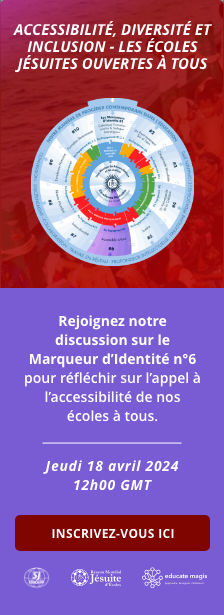In this second blog about Christus Vivit, the Spanish scholastic Pedro Rodriguez, who works at Colegio San Ignacio de Piura in northern Peru, reflects on how in the apostolic exhortation, Pope Francis invites all who work with young people to learn about his vehemence and his creativeness.
If we journey together, young and old, we can be firmly rooted in the present, and from here, revisit the past and look to the future. To revisit the past in order to learn from history and heal old wounds that at times still trouble us. To look to the future in order to nourish our enthusiasm, cause dreams to emerge, awaken prophecies and enable hope to blossom. Together, we can learn from one another, warm hearts, inspire minds with the light of the Gospel, and lend new strength to our hands. (Christus Vivit 199)
Every morning I open my office at Colegio San Ignacio de Loyola (in Piura, Peru) and I spend most of the day speaking to young people ranging from 12 to 17 years old. In the afternoon, I work at institición Canat; where were young workers in extreme poverty, come to see me and share their particular vision of the world. Finally, in the evening, when the classrooms are closed, I return to the school that begins to fill up with university students, who come to school premises to meet for various reasons: faith- sharing groups, volunteering or spiritual accompaniment. All these young people share three things in common: choice, illusion and “folly”.
In the Apostolic Exhortation Christus Vivit, Pope Francis speaks to us in some way of these three dimensions. Youth is the time in which great decisions are made: it is the vital moment in which paths are chosen and sidewalks put aside. Traditionally, there has always been an emphasis on childhood the key moment of a person’s development. Even though this is the case, we must not forget that it is during our young years we make choices that determine our higher education, our careers, our relationships, and our lifestyle… in this regard, it is at our youth that we set our personal goals and dream of a real and plausible future.
Those of us who have accompanied young people during these years (i.e. parents, teachers, spiritualists, psychologists, etc.) are called to assist young people to obtain (in some way) the sufficient freedom; so that they can take decisions in their lives without “ties” or ”hooks”. The great lesson we can offer them is not one on mathematics or social sciences. Instead, we should teach them about the indifference of which Saint Ignatius of Loyola writes about in the Spiritual Exercises. In this way, young people can discern by listening to the call that Our Lord makes to each one of them in a particular way: to listen to that Jesus who walks beside them.
The big decisions that young people have to make can only be made from hope: which is one of the strongest assets of the youth In this regard, there is nothing harder than seeing a young person without hope. When sadness have taken hold of her, her being I has been distorted like the picture of Dorian Grey. In other words, a black soul without wrinkles or signs of old age: incapable of living fully. The vitality which is hope (and the very act of living) dissipates the shadows and generates creative solutions to problems. Therefore, the young person is able to overcome “deserts” of her desolation or walk among the difficulties of life, with the sole purpose of making her dreams a reality.
The young people may simply look like “younger adults” but they hide a spirit with more “folly” than rationalism. In other words, they play with the possibility of another world, they dream of changing their surroundings. This makes them open to new possibilities and to think out of ordinary. For this reason, I think that young people can teach the so-called wise. While the “wise “merely paints horizons, the young person is the gap between the heavens and the earth: the path that is infinite and that seems to have no end. In this regard, God himself has shared these qualities with the youth: a creative attitude and a capacity for total renewal or recreation.
Finally, to take care of the young is to take care of the Common Home, as well as to show them an image of Christ. In this way, the young may become in touch with Christ virtues, values, and his humanity. It is to give them the opportunity to have a fuller life: rich in meaning and open to others. Additionally, it is an opportunity to grow out of individualism and selfishness. A young person who feels the presence of God in her life will be able to integrate her sense of hope and her “folly” when taking big decisions in life. And hopefully, this faith-inspire decision will shape her world from the measures of freedom, justice and love.
Se connecter ou Adhérer
pour créer et afficher des commentaires

